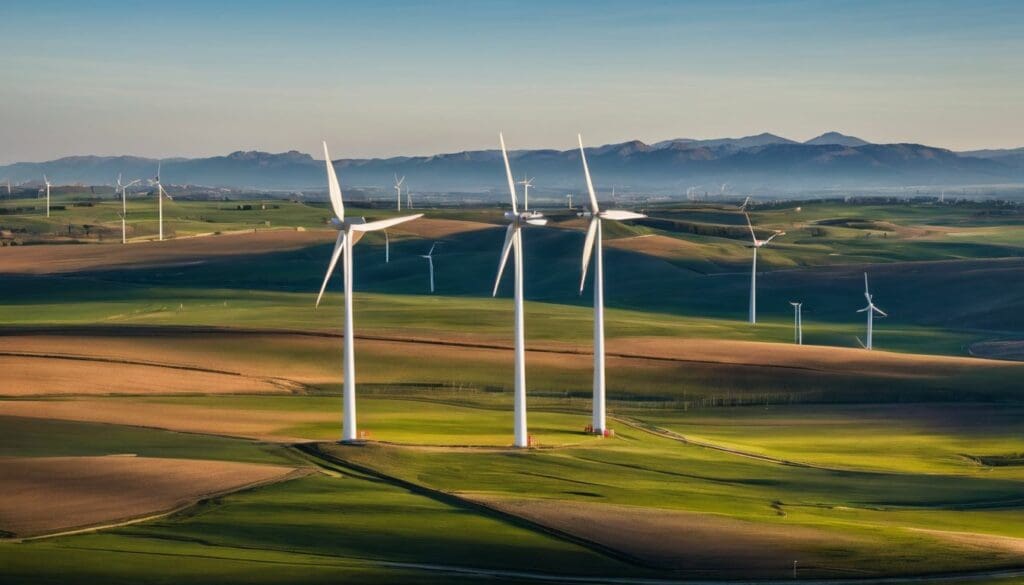As we strive to be greener, understanding how our energy choices impact the planet can be a puzzle. Renewable Energy Certificates (RECs) offer one piece of that solution – ensuring electricity is sourced from sustainable practices.
This article unravels the REC mystery, guiding you through their benefits and workings to empower your eco-friendly decisions. Dive in for clarity on green energy gains!
Key Takeaways
- Renewable Energy Certificates, known as RECs, act as proof that 1 megawatt – hour (MWh) of electricity has been generated from a renewable source and fed into the grid.
- The purchase and use of RECs enable businesses and individuals to support sustainable energy initiatives without having to directly consume green power.
- There are different types of RECs such as Solar, Wind, Hydroelectric, Biomass and Geothermal, each linked to specific types of renewable energy sources.
- Investing in RECs can provide financial benefits by potentially reducing electricity costs over time whilst promoting environmental sustainability by supporting clean energy projects.
- Prior to investing in RECs it is crucial for individuals or organisations to understand their own sustainability goals and commitment level as well as the financial implications.
What are Renewable Energy Certificates (RECs)?
Renewable Energy Certificates (RECs) are market-based instruments that represent the legal property rights to renewable energy generation. They come in different types and can be traded as non-tangible commodities, providing proof of renewable energy production.
Definition
Renewable Energy Certificates (RECs) represent the environmental attributes from renewable electricity generation. Think of RECs as birth certificates for units of green power; each one verifies that one megawatt-hour (MWh) of clean energy has flowed into the electricity grid.
They are market-based instruments that certify the bearer owns a specific amount of renewable power. When someone produces or uses renewable energy, legal property rights to these non-tangible commodities arise.
Owners can trade, sell, or keep these certificates to demonstrate sustainability efforts and reduce carbon footprints. The process ensures transparency in the renewable energy market and helps track progress towards conservation goals.
Tradable renewable energy certificates play a vital role in certifying proof of renewable energy generation and promoting investments into cleaner energy sources without confusing paperwork or technical complexities.
Types
Renewable Energy Certificates (RECs) come in different types, each representing a specific source of renewable energy. These types include:
- Solar RECs: Generated from solar energy sources
- Wind RECs: Derived from wind energy production
- Hydroelectric RECs: Originating from hydroelectric power stations
- Biomass RECs: Produced from organic waste materials and dedicated energy crops
- Geothermal RECs: Stemming from geothermal energy extraction
How RECs work
- Renewable energy generators register their facilities with appropriate certification programmes and produce RECs for each MWh of electricity generated from a renewable source.
- Once the RECs are created, they can be sold or traded separately from the actual electricity. This allows consumers or businesses to purchase and use renewable energy attributes without physically consuming the electricity itself.
- When a consumer or company purchases RECs, they are effectively supporting the development of renewable energy production by ensuring that a certain amount of clean energy is added to the grid on their behalf.
- Purchasing RECs also enables individuals and organisations to claim that they are using renewable energy, thereby helping them meet their sustainability goals and support environmental conservation efforts.
Requirements
Renewable Energy Certificates (RECs) are essential for organisations and individuals looking to support renewable energy. To obtain RECs, entities must generate electricity from eligible renewable sources such as wind, solar, or hydro.
The generation of one REC is typically based on the production of one megawatt-hour (MWh) of renewable energy. These certificates must meet specific criteria regarding their origination and environmental attributes to ensure they represent genuine contributions to sustainable energy generation.
To participate in the Renewable Energy Certificate market, entities need to adhere to the regulations set by relevant certification programs and ensure that their RECs are issued through approved channels.
It’s crucial for participants to understand these requirements before engaging in any REC-related transactions or investments in order to promote transparency and accountability within the renewable energy sector.
Benefits of RECs
RECs provide proof of renewable energy, support renewable energy development and help organisations meet sustainability goals. Want to know more about how RECs can benefit you? Keep reading to find out!
Providing proof of renewable energy
Renewable Energy Certificates (RECs) serve as tangible proof that electricity is generated from renewable sources. They represent the environmental attributes of one megawatt-hour (MWh) of renewable energy and validate the use of clean energy.
By purchasing RECs, individuals and organisations directly contribute to the development and growth of renewable energy projects while fulfilling their sustainability goals.
Supporting conservation efforts goes beyond mere intentions; it involves taking real action by investing in RECs. This not only demonstrates a commitment to environmental responsibility but also drives positive change towards a more sustainable future.
Supporting renewable energy development
By purchasing Renewable Energy Certificates (RECs), you can directly contribute to the growth of renewable energy sources. Your support incentivises the development and investment in clean, sustainable energy infrastructure.
This enables more companies to invest in renewable energy projects, ultimately reducing carbon emissions and promoting a greener future for our planet.
Encouraging the use of RECs also helps create a market demand for renewable energy, prompting further innovation and technological advancements in the industry. This active involvement not only facilitates access to cleaner sources of power but also fosters economic growth within the renewable energy sector, ensuring a sustainable future for generations to come.
Helping organisations meet sustainability goals
Supporting renewable energy development not only benefits the environment but also helps organisations meet their sustainability goals. By investing in Renewable Energy Certificates (RECs), businesses can demonstrate their commitment to supporting clean energy sources and reducing their carbon footprint.
This proactive approach aligns with corporate social responsibility initiatives, enhancing brand reputation and attracting environmentally conscious consumers.
In addition, utilising RECs can contribute to achieving sustainability targets by offsetting conventional electricity usage with certified renewable energy generation. It enables organisations to play an active role in driving the transition towards a more sustainable future while positively impacting the environment and society as a whole.
Differences between RECs and SRECs
RECs and SRECs differ in terms of their tangible or non-tangible nature, the types of renewable energy sources they represent, and regional variations in their issuance. Understanding these differences can help individuals and organisations make informed decisions about investing in renewable energy certificates.
Non-tangible commodities vs physical certificates
Renewable Energy Certificates (RECs) are non-tangible commodities traded in the energy market. They represent the environmental attributes of renewable electricity generation. On the other hand, Solar Renewable Energy Certificates (SRECs) are physical certificates certifying that a certain amount of electricity was generated from solar energy sources.
While RECs can be bought and sold independent of the actual electricity, SRECs are physically issued for each megawatt-hour (MWh) of solar power generated.
The difference lies in their tangible presence – RECs being intangible commodities and SRECs being physical certificates directly linked to solar energy production. Both play a crucial role in supporting renewable energy development and enabling organisations to meet sustainability goals, albeit through different mechanisms.
Renewable energy sources
Renewable energy sources encompass solar, wind, hydro, and biomass. Solar energy is harnessed from the sun’s rays using photovoltaic cells or solar panels. Wind power utilises turbines to convert wind into electricity.
Hydroelectric power generates energy from flowing water in rivers and dams, whilst biomass comes from organic materials like wood and agricultural waste.
Hydropower holds significant potential due to its reliable output, whilst solar energy is abundant but varies based on daylight availability. Biomass provides a consistent supply of renewable fuel through organic waste conversion.
Regional variations
Regional variations in Renewable Energy Certificates (RECs) exist due to differences in renewable energy generation and consumption across various geographical areas. These variations involve factors such as the availability of renewable resources, state regulations, and market demand for green energy.
As a result, the value and pricing of RECs can fluctuate from one region to another. Additionally, the types of renewable energy sources prevalent in different locations impact the issuance and trading of RECs.
Understanding these regional nuances is crucial for organisations looking to invest in RECs or participate in renewable energy trading activities.
Pros and Cons of RECs
Pros of RECs include providing proof of renewable energy and supporting sustainability goals, while the cons may include potential financial costs and market volatility. Further discussion on these points will be explored in this section.
Pros:
Renewable Energy Certificates (RECs) offer numerous advantages for environmentally conscious individuals and organisations. Firstly, they provide a clear proof of renewable energy usage and can be used to demonstrate commitment to sustainability goals.
Secondly, investing in RECs supports the development of renewable energy sources, creating a positive environmental impact by reducing reliance on fossil fuels. Additionally, participation in REC programmes helps businesses and individuals contribute to the overall growth of the green energy market while boosting their own eco-friendly credentials.
Moreover, buying RECs allows consumers to directly support clean energy projects without having to install onsite generation equipment. This presents an effortless way for everyone to make a significant difference towards conservation efforts.
Cons:
– Cons: Despite their benefits, Renewable Energy Certificates (RECs) also have some drawbacks. One disadvantage is the potential for greenwashing, where organisations may purchase RECs without making substantial efforts to reduce their actual carbon footprint.
Additionally, due to the complex nature of REC markets and varying state regulations, there can be a lack of transparency and accountability in the certificate trading process.
While RECs offer a means for companies to offset their carbon emissions, some critics argue that they could divert attention from more significant action towards reducing energy consumption and transitioning to truly renewable sources.
Is Investing in RECs Worth It?
Investing in RECs can potentially provide financial benefits and have a positive environmental impact. However, there are considerations to take into account before making an investment decision.
Potential financial benefits
Investing in Renewable Energy Certificates (RECs) can lead to potential financial benefits for both individuals and organisations. By purchasing RECs, you can support renewable energy production while also potentially lowering your electricity costs over time.
The market-based instrument of RECs allows the monetisation of renewable energy certificates, providing a financial incentive for renewable energy development.
Furthermore, investing in RECs may contribute to long-term cost savings through reduced reliance on fossil fuels and traditional electricity sources. This not only supports environmental sustainability but also has the potential to offer positive economic outcomes by diversifying and stabilising energy portfolios.
Environmental impact
Renewable Energy Certificates (RECs) have a significant environmental impact as they support the development of renewable energy sources. By purchasing RECs, individuals and organisations contribute to the reduction of greenhouse gas emissions and promote clean energy generation.
This investment directly helps in offsetting conventional electricity production, leading to cleaner air and water, while also reducing reliance on non-renewable resources.
Supporting RECs has a positive effect on wildlife habitats and biodiversity by lessening the environmental degradation caused by traditional energy sources. It encourages sustainable practices that benefit ecosystems and reduce land-use conflicts associated with fossil fuel extraction.
Considerations before investing
Before investing in RECs, be sure to consider the following points:
- Understand your energy usage and identify how RECs can offset your carbon footprint.
- Research the credibility of the issuing agency or programme to ensure the legitimacy of the certificates.
- Evaluate the cost versus benefits, considering potential savings and environmental impact.
- Assess your long – term commitment to renewable energy and how RECs align with your sustainability goals.
Conclusion
Renewable Energy Certificates (RECs) are essential market-based instruments that provide proof of renewable energy. With their ability to support renewable energy development and help organisations meet sustainability goals, RECs play a crucial role in driving the adoption of clean energy.
Understanding the differences between RECs and SRECs, as well as weighing the pros and cons, can guide individuals and organisations in making informed decisions about investing in RECs.
Ultimately, grasping the potential financial benefits and environmental impact of RECs is key for those considering participation in renewable energy certificate programmes.
FAQs
1. What exactly are renewable energy certificates?
Renewable energy certificates, also known as credits, are market-based instruments that represent the property rights to the environmental benefits of generating one megawatt-hour (MWh) of renewable energy.
2. How do renewable energy certificate programmes work?
These programmes enable producers and consumers to trade these tradable commodities, where issuance and purchase signify support for renewable energy generation and use.
3. Can I make money from renewable energy certificates?
Yes, through a process called monetisation, you can earn revenue by selling your accumulated renewable energy credits in the market at current pricing rates.
4. Why buy Renewable Energy Certificates?
Purchasing these certificates is a means for individuals or businesses to contribute to sustainable practices without directly producing their own green power.





